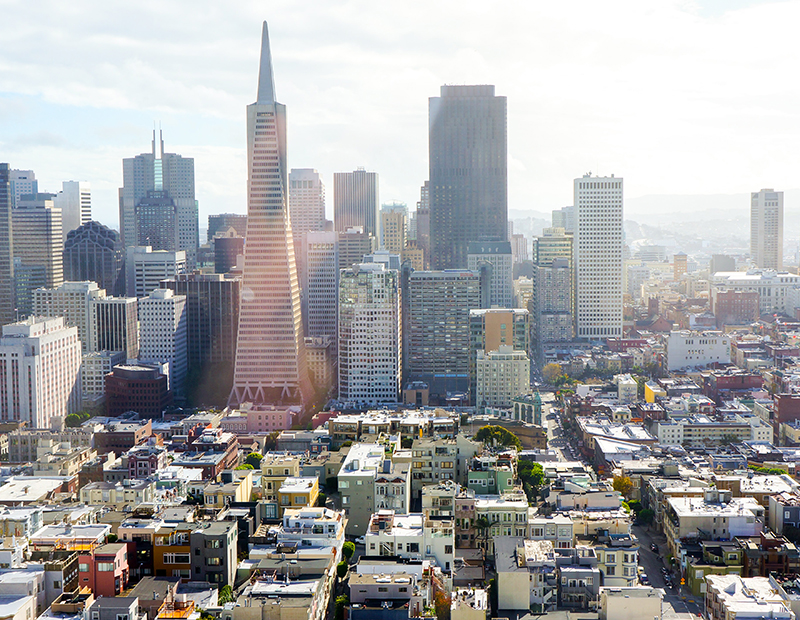San Francisco’s Office Market Shows Signs of Life
Once a boon, the Bay Area's tech-centricity quickly became a liability. The tide, however, is turning again.
With demand plummeting in 2020, San Francisco could easily be labeled as one of the country’s most sluggish office markets in the short term, if not the most. While current fundamentals may leave little room for comfort, there’s more to say about the future than meets the eye.
“Leasing demand was off by more than 70 percent in 2020, as most companies that are leasing office space have executed a work-from-home strategy,” Mark Christierson, executive vice president at CBRE, told Commercial Property Executive.
The stark challenges facing San Francisco’s office market were underscored by the relocation of tech heavyweights and plans to embrace a more permanent remote work culture, pushing up the vacancy rate for both direct available and sublease office space.
As of February, the overall vacancy rate in San Francisco stood at 12.8 percent, up 550 basis points year-over-year. The metro had more than 11.3 million square feet of direct available space and nearly 7 million square feet was listed for sublease, CommercialEdge data shows.
READ ALSO: Market Update: Sales Still Slow by Bay Area Standards
Despite the rising vacancy rate, Peter Conte, senior vice president in Transwestern’s San Francisco office, argued that the metro has always been one of the most dynamic cities, with “faster booms and busts than the average market,” therefore also bound to recover faster. He also noted that while there is an abundance of sublease space on the market, this also marks an opportunity for startup groups to expand and capitalize on newly available space.
En route to recovery
According to a recent Newmark study, sublet space availability has plateaued in recent months in San Francisco, even experiencing modest declines, compared to the fourth quarter of 2020. Some sublease space was most likely listed on a speculative basis, mostly by tech companies looking to cover rent costs, rather than expectations of a long-term footprint shrinkage. What’s more, some of this sublease space is being pulled off the market, the researchers noted.
With vaccination campaigns ramping up, office users are becoming increasingly optimistic and are tapping into the idea of returning to the office. “Office demand is on the rise. Slowly but surely the vaccine and the realization that normalcy is around the corner has kicked off FAANG (Facebook, Amazon, Apple, Netflix and Google) demand. With FAANG demand comes ‘safety’ for others to initiate projects,” noted Nick Slonek, principal & managing director in Avison Young’s San Francisco office.
Slonek also pointed out that the Bay Area recorded a more than 60 percent increase in office inquiries going into 2021. “Tour activity is up over 30 percent, and proposal activity is up over 40 percent year-over-year,” he added.
According to VTS’ Office Demand Index report, which tracks tenant interest based on office tours by prospective tenants, office demand in San Francisco rebounded by almost 95 percent from the lowest point around mid-2020. This could lead to stronger leasing activity in upcoming quarters, pushing the Bay Area’s office market closer to recovery.
Who is leasing now in San Francisco?
Jeffrey Rogers, president of Briggs Development, a company that develops and manages office buildings in the Bay Area, noticed that as companies are becoming more confident about their needs beyond the pandemic, leasing activity has increased across Briggs’ portfolio. “As the pandemic progressed, we did see a few tenants vacate as their leases expired, but we were very pleased to have new tenants lease space with more leasing conversations underway,” he said.
Currently, the most-active tenants in the market are professional services and life sciences companies, and those affiliated with them. These companies “tend to look for flexible, multiuse zoning, large/open format spaces that cannot be replicated from the home office and can pivot use in the future for their business needs,” according to Conte.
Indeed, the type of space and its location will be critical in determining the success of office buildings in the future. The recent record $1.1 billion sale of The Exchange on 16th, a 750,000-square-foot office asset in San Francisco’s Mission Bay neighborhood, exemplifies the future needs of office owners and tenants. The LEED Platinum-certified building serves as the headquarters of Dropbox. However, the tech company adopted a permanent remote work strategy and offered half of the building for sublease.
Vir Biotechnology subleased nearly 134,000 square feet at The Exchange on 16th, about one-third of the space that Dropbox put on the market. Last week, Dropbox confirmed that it has signed another, 52,604 square feet lease with BridgeBio—a drug development firm—marking the property’s second biotech deal, the San Francisco Chronicle reported.
READ ALSO: The Life Science Industry’s Transformation
Meanwhile, professional services tenants are mostly renewing, usually for less, or trying to capitalize on current market conditions by either lowering their occupancy costs or taking the opportunity for a flight-to-quality, said Slonek.
Slonek anticipated that leasing activity for tech companies will increase in the second half of the year. For now, these tenants are “taking advantage of pre-built, low upfront CapEx transactions that will band-aid their expansion to put big decisions off for a while longer,” he added.
Nonetheless, by the third and fourth quarters of 2021, the Bay Area should slowly get back into shape. “We anticipate demand and gross leasing activity to be back to ‘normal’ averages by 2022,” said Slonek. “Once data points start to hit the market with regularity, both landlords and tenants will be equipped to feel better about making big decisions. Until that time, we will continue to see sporadic activity amongst professional services and technology companies,” he concluded.










You must be logged in to post a comment.